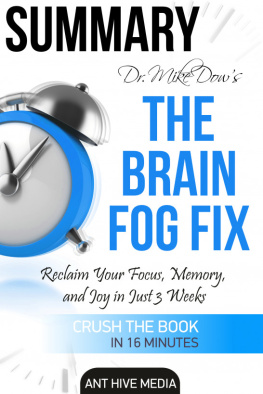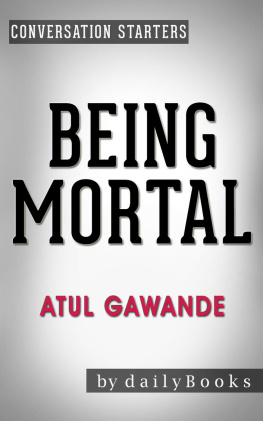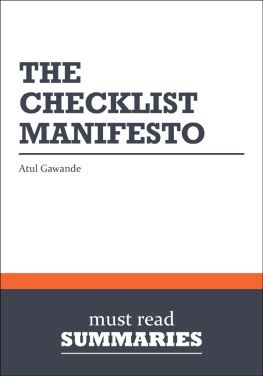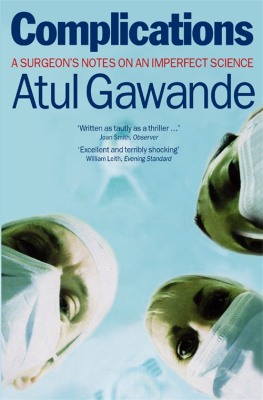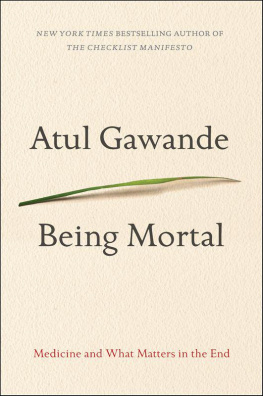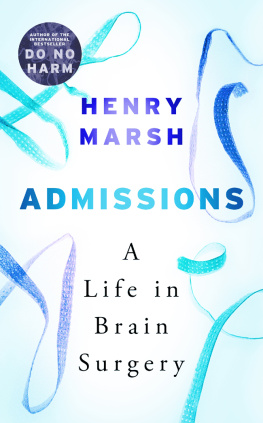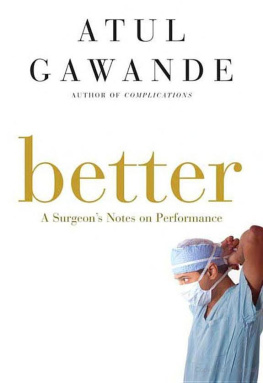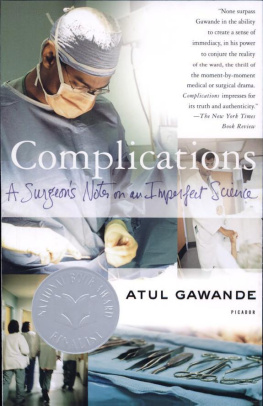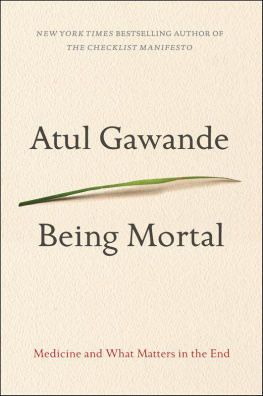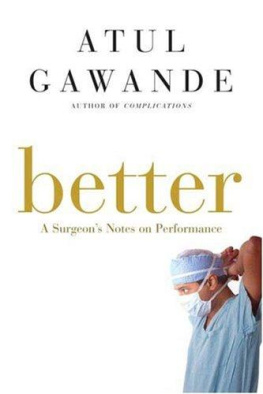Atul Gawandes
Being Mortal
Medicine and What Matters in the End
Summary by Ant Hive Media

Visit:
www.anthivemedia.com/freesummaries
to receive your pack of (5) e-booksummaries
FREE!
Check us out on Instagram:
www.instagram.com/anthivemedia/
Follow along on Facebook:
www.facebook.com/AntHiveMediaSocial
Please Note
This is a Summary of the original book. AntHive Media reads every chapter, extracts the understanding andleaves you with a new perspective and time to spare. We do the workso you can understand the book in minutes, not hours.
Smashwords Edition License Notes
This eBook is licensed for your personalenjoyment only. This eBook may not be re-sold or given away toother people. If you would like to share this book with anotherperson, please purchase an additional copy for each recipient. Ifyoure reading this book and did not purchase it, or it was notpurchased for your enjoyment only, then please return toSmashwords.com or your favorite retailer and purchase your owncopy. Thank you for respecting the hard work of this author.
Copyright 2016 by AntHive Media .
All rights reserved worldwide. No part ofthis publication may be reproduced or transmitted in any formwithout the prior written consent of the publisher.
Disclaimer:
The fact that an individual or organizationis referred to in this document as a citation or source ofinformation does not imply that the author or publisher endorsesthe information that the individual or organization provided. Thisconcise summary is not intended to be used without reference to theoriginal book
Table of Contents
A GIFT FOR YOU
As a way of saying thank you we want to
offer you a pack of (5) e-book summariesFREE!
Available Here:
www.anthivemedia.com/freesummaries

OVERVIEW
BeingMortal, by writer Atul Gawande focuses on several critical issuesthat include death, aging, mortality and critical and terminalillness. The writer has included vast research and has chronicledstories and experiences of his own patients, patients of otherdoctors and stories of his members of the family. The story basedon these experiences provides information to readers regardingvarious circumstances, life situations and scenarios, which canfacilitate people to find an optimum journey through the final daysof their own lives or the lives of their family members.
Gawande glances through the practicalproblems and history of the common methods used by the ill andelderly persons when it becomes impossible for them to take theirown care. These methods primarily consist of nursing homes,hospitals, hospice and assisted living. He analyses the positiveand negative aspects of each one of them while evaluating the levelof autonomy allowed by each option.
The concept of autonomy is important toboth, the narrative of Gawande and any person who suffers fromaging, sickness and death. Gawande also evaluates other scenarioand concepts that are faced by those on their deathbeds such as ifthey want to pursue treatment till the end of their lives despiteknowing that such treatments can shorten their life or affect thequality of their life adversely.
Throughout this book there are variouspersonal stories of people interspersed and these are weavedtogether based on the research conducted by Gawande research, hisanalysis and conceptual explanations. These stories exemplify thevarious points he states. Herewith is an in-depth description ofthe life of the writers father and the struggle of GawandesFather tying to maintain the life he could manage to enjoy evenwhile battling with the paralyzing tumor. Gawande requests otherdoctors to analyze their own experiences they had with theirpatients who were in similar situation where the death was imminentand emphasized the criticality to take palliative care infuture.
IMPORTANT PEOPLE
Atul Gawande : He isthe writer of this book and also plays a role as either the doctoror the relative of the patients in few of his personal stories thathe has shared in this book.
Atmaram Gawande :Atmaram was father of Atul Gawande. Atmaram was diagnosed to havinga tumor in the spinal cord. Author chronicles the life of hisfather from his pre-tumor days till his death in this book.
Alice Hobson : Alicewas Gawandes wifes grandmother. She represents one of the firstencounters of Gawande with mortality and aging.
Sitaram Gawande :Sitaram was the grandfather of Atul Gawande and lived in Indiaindependently till he was old age and was taken care of by severalfamily members. In this book, Atul Gawande uses his grandfather asthe example of old ways of taking care of the elders in the familybefore the advent of modern medicine.
Lou Sanders : LouSanders was an elderly person who moved to live with his owndaughter while he was growing older. Lou later struggledsignificantly while being taken care of in assisted living since itbecame unbearable for his daughter to take care of him.
Sara Monopoli : Sarawas just in thirties and was pregnant expecting her first baby whenshe discovered that she had lung cancer and would die. Gawandenarrates her story to signify the point the continuing thetreatments despite all odds may not be the right healthcarestrategy.
Peg Bachelder : PegBachelder was Gawandes daughter Hunters piano teacher. Pegsuffered from a rare, type of cancer, the soft-tissue cancer andhad to eventually live on hospice; however she continued with pianolessons till she was alive since it made her feel that she has apurpose.
A SUMMARY OF CORE CONCEPTS
Nursing homes neither have beencreated for assisting elderly persons to reduce their level ofdependency on another person nor to provide better options than thepoorhouses. The purpose for creating nursing homes is clearinghospital beds.
Assisted living therefore has risen from therequirement to provide alternative solution to nursing homes, whichcan make patients more independent and have a better grip overtheir own lives.
Most people, in the later years of their ownlives want something more than survival and that is where nursinghomes, medical institutions and assisted living fail.
People must question what makes life worthliving at the time when they get old, are frail, ill and have todepend on another person for their daily care.
People who discuss about the end of the lifecan assuage the perplexity and the burden felt by them, members oftheir family and even their doctors in the instances their death iscertain and it can lead to a betterment of the quality of theirlife.
In the face of death, people are needed todecide how far they wish to go when it comes to the treatment forextending their life, which ultimately would compromise the qualityof their life.
Assisted living and the nursing homes areoften inclined more towards benefitting the children of patientsmore than the patients themselves. Their children are generallydecision makers at lifes end of their parents.
Autonomy is an important human need which isgenerally forgotten or avoided when people are nearing theirdeath.
Hospice care is not intended towardssurrendering to the death. Instead it is a manner for the patientsto improve the quality of their life.
Doctors generally struggle while speakingwith their patients regarding the truth of the status of theirhealth as well as the probable results of the treatment.


